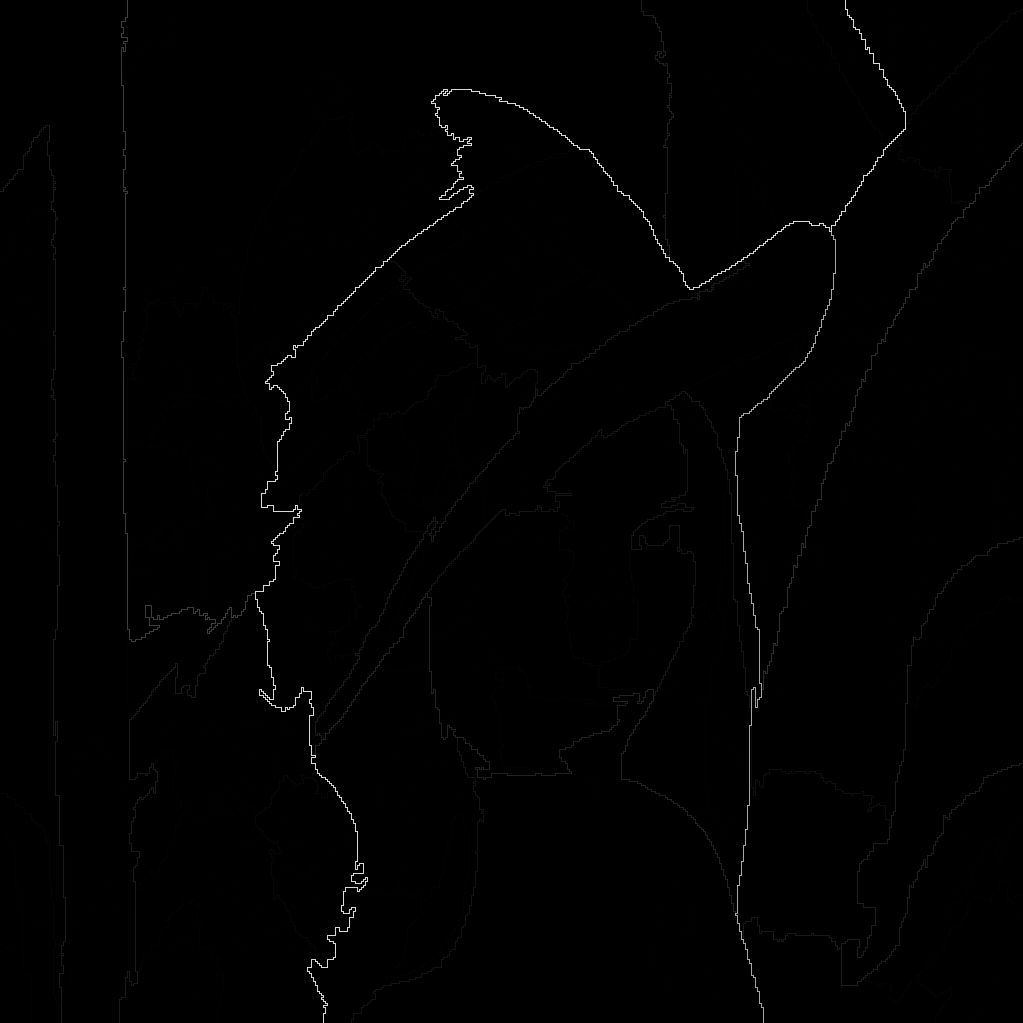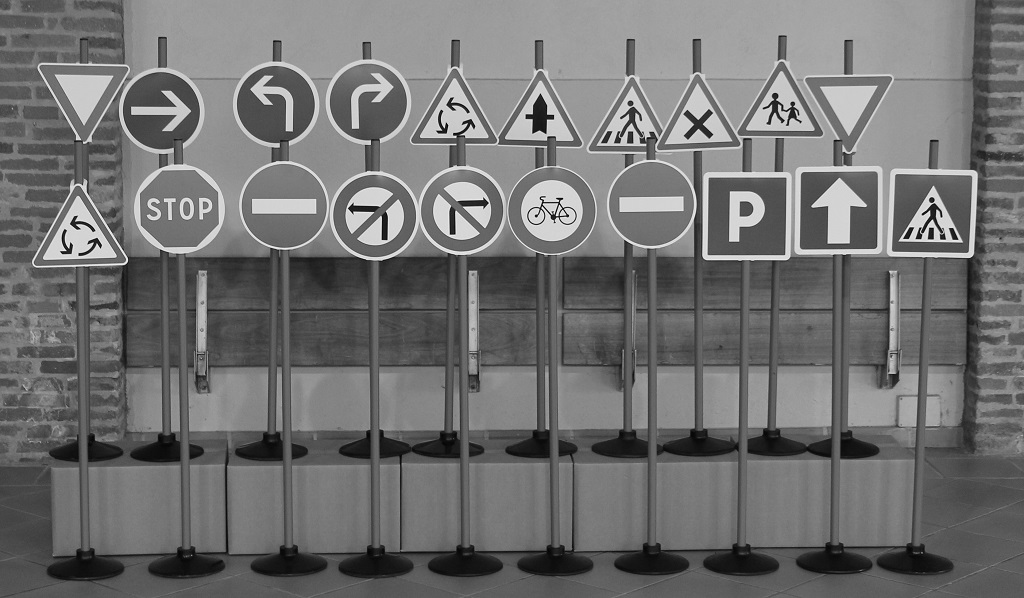Component Trees (Overview)
Include
<mln/morpho/component_tree.hpp>Include
<mln/morpho/maxtree.hpp>Include
<mln/morpho/tos.hpp>
Component trees are morphological hierarchical representations of images based on their level set decomposition:
The min-tree organizes lower connected-components into a tree:
\[\Gamma^- = \{ CC(X) : X \in [u \le \lambda] \}\]The max-tree organizes upper connected-components into a tree:
\[\Gamma^+ = \{ CC(X) : X \in [u \ge \lambda] \}\]The tree of shapes merges the hole-filled components of the min and max-trees into a single tree.
Input |
Min-tree |
Max-tree |
Tree of Shapes |
Component tree Internal Representation
A tree is represented as an array of nodes where a node contains:
The index of the parent node
The level of the current node
The component_tree is thus composed of two arrays:
A
parentarray with element of typeintA
levelarray
These arrays are sorted in the topological order, that is, we have parent[i] < i. The parent of the root
node is -1 (parent[0] = -1).
The correspondance between the pixels and the node they belong is stored in an image, called the node_map.
Node map |
Component tree internal arrays |
Computing trees
See Max-tree and Tree of Shapes (ToS).
Tree traversal examples
Attribute Computation
It is common to associate values to nodes. The implementation keeps a distinction between the data structure (the tree) and the values associated to the nodes through property maps. A property map is a mapping node id -> value that is encoded with a standard vector.
Here is a example to compute the number of children per node for a tree t:
// Declare and initialize to 0 a property map for the tree `t`:
std::size_t n = t.size();
std::vector<int> nchildren(n, 0);
for (int i = n - 1; i > 0; --i)
nchildren[t.parent[i]]++;
One may compute features for each component of the tree (e.g. for filtering) related with the image content. Most common attributes are related to the shape of the component or its colors, e.g.:
The size of the component
The average gray level of the component
The circularity of the component
…
A component_tree t has the following methods.
-
auto compute_attribute_on_points(Image node_map, Accumulator accu, bool propagate) const
-
auto compute_attribute_on_values(Image node_map, Image values, Accumulator accu, bool propagate) const
-
auto compute_attribute_on_pixels(Image node_map, Image values, Accumulator accu, bool propagate) const
Accumulate the points of each component.
- Parameters:
node_map – An image thats maps: point -> node id
values – An image where values to accumlate are taken from
accu – The feature to compute
propagate – Option to propagate the values to the parent (default: true)
- Returns:
A vector mapping for each node the result of accumulation.
Pseudo-code:
std::vector<Acc> accus(n); std::vector<...> result(n); // (1) On points mln_foreach(auto px, node_map.pixels()) accus[px.val()].take(px.point()); // or (2) On values auto zz = mln::ranges::view::zip(node_map.values(), values.values()); mln_foreach((auto [id, v]), zz) accus[id].take(v); // or (3) on pixels mln_foreach(auto px, values.pixels()) accus[node_map(px.point())].take(px); for (int i = n-1; i > 0; --i) accus[parent[i]].take(accus[i]); std::ranges::transform(accus, result, [](auto&& a) { return a.to_result(); });
Example: computing the size (number of points) of the components.
#include <mln/accu/accumulators/count.hpp>
auto sizes = tree.compute_attribute_on_points(node_map, mln::accu::features::count<>());
-
auto compute_depth() const
Compute the depth attribute for each node where depth stands for the length of the path from the root to the node. (the root node has a null depth).
- Returns:
An int vector mapping node_id -> int
Tree Filtering
Filtering is also a common operation on morphological trees to simplify the tree or filter some unwanted shapes. Let pred be a predicate where pred(x) = true says that we want to preserve the node of id x. We have the following filtering strategies.
MIN (CT_FILTER_MIN)
A node is remove if it does not pass the predicate and all its descendant are removed as well. Formally, a component Γ is kept if 𝓒(Γ) with 𝓒(Γ) = ⋁ { 𝓟(Γ’), Γ ⊆ Γ’ }.
MAX (CT_FILTER_MAX)
A node is remove if every node in its childhood does not pass the predicate. All its descendant are removed as well. Formally, a component Γ is kept if 𝓒(Γ) with 𝓒(Γ) = ⋀ { 𝓟(Γ’), Γ’ ⊆ Γ }.
DIRECT (CT_FILTER_DIRECT)
A node is remove if it does not pass the predicate, the others remain.
A component_tree t has the following methods.
-
void filter(ct_filtering strategy, Predicate pred)
-
void filter(ct_filtering strategy, Image node_map, Predicate pred)
Filter the tree according to a given strategy. If node_map is provided, it is updated so that pixels map to valid nodes.
- Parameters:
strategy – The filtering strategy
node_map – (Optional) An image thats maps
point -> node idpred – The predicate fuction
node id -> bool
Example
Here is an example of filtering to collapse the nodes part of a chain to simplify the tree:
#include ... // as above #include <mln/morpho/component_tree.hpp> component_tree<uint8_t> t = ...; std::vector<int> nchildren; // Compute the attribute node_id -> #number of children (see above) auto pred = [&](int id) { nchildren > 1; }; t.filter(CT_FILTER_DIRECT, pred);
Image reconstruction
The next step after image filtering is generally the reconstruction of the image from the filtered tree.
-
auto reconstruct(Image node_map)
-
auto reconstruct_from(Image node_map, std::span<V> values)
Reconstruct the tree from the initial levels or from levels taken from the parameter values.
- Parameters:
node_map – An image thats maps
point -> node idvalues – (Optional) Recontruction values (default is
t.levels)
Example
Connected opening of size 20:
auto [t, node_map] = ...; // Tree Computation auto area = t.compute_attribute_on_points(node_map, mln::accu::features::count<>()); t.filter(CT_FILTER_DIRECT, [&area](int id) { return area[id] > 20; }); auto out = t.reconstruct(node_map);
Horizontal cut
When the tree is a hierarchy of partition, such as the Alpha Tree, it is possible to make an horizontal cut of this tree.
-
I horizontal_cut(const T threshold, I nodemap) const
-
I horizontal_cut_from_levels(const T threshold, I nodemap, ::ranges::span<V> levels) const
Make an horizontal cut at threshold
thresholdof the tree and return the nodemap associated to the cut.- Parameters:
threshold – The threshold of the horizontal cut
nodemap – An image thats maps
point -> node idlevels – (Optional) The altitude of each node in the tree (for example the \(\alpha\) associated to each node for the alphatree).
Saliency Computation
It is also possible to compute the saliency map to obtain another visualization.
-
auto saliency(image2d<int> node_map, ranges::span<double> values) const
Compute and return the saliency map of the tree. Works only for 2D images and with tree node values of type
double.- Parameters:
node_map – An image thats maps
point -> node idvalues – the levels of the tree for each node
- Returns:
The saliency map as an image

|

|
Original image |
Saliency map of the watershed hierarchy by area |
A complete example
Filtering the square roadsigns.

Method description
The method will proceed as follows:
Compute the ToS of the input image:
auto [t, node_map] = mln::morpho::tos(f);
The ToS uses a special representation that needs to double the size of the image by adding intermediate pixels. We thus need to reconstruct an image of the right size:
mln::image2d<uint8_t> f2 = t.reconstruct(node_map);
Compute the bounding box, the size and the variance of each shape. We create a custom accumulator object for this, whose implementation is described below in the full code section:
struct my_accu_t : mln::Accumulator<my_accu_t> { using result_type = my_accu_t; using argument_type = mln::image_pixel_t<mln::image2d<uint8_t>>; my_accu_t() = default; template <class Pix> void take(Pix px) { ... }; void take(const my_accu_t& other) { ... }; int count() const { ... } int area_bbox() const { ... } double variance() const { ... } my_accu_t to_result() const { return *this; } }; auto prop_map = t.compute_attribute_on_pixels(node_map, f2, my_accu_t{});
Filter the objects that:
are not too big (< 1000 x 1000 pixels)
are not too small (> 100 x 100 pixels)
cover 95% of the bounding box at least (so rectangular shapes)
auto pred = [&prop_map](int x) { int sz = prop_map[x].count(); return sz > (0.95 * prop_map[x].area_bbox()) && sz > 10000 and sz < 1000000 and prop_map[x].variance() > 250; }; // Filter t.filter(mln::morpho::CT_FILTER_DIRECT, node_map, pred);
Reconstruct the image:
t.values[0] = 0; // Set the root gray level to 0 auto out = t.reconstruct(node_map);

Full code
#include <mln/core/image/ndimage.hpp>
#include <mln/accu/concept/accumulator.hpp>
#include <mln/io/imread.hpp>
#include <mln/io/imsave.hpp>
#include <mln/morpho/tos.hpp>
#include <mln/morpho/maxtree.hpp>
struct my_accu_t : mln::Accumulator<my_accu_t>
{
using result_type = my_accu_t;
using argument_type = mln::image_pixel_t<mln::image2d<uint8_t>>;
my_accu_t() = default;
void init() { *this = my_accu_t{}; }
template <class Pix>
void take(Pix px)
{
auto p = px.point();
auto v = px.val();
m_count++;
m_sum += v;
m_sum_sqr += v * v;
m_xmin = std::min((int)p.x(), m_xmin);
m_xmax = std::max((int)p.x(), m_xmax);
m_ymin = std::min((int)p.y(), m_ymin);
m_ymax = std::max((int)p.y(), m_ymax);
}
void take(const my_accu_t& other)
{
m_count += other.m_count;
m_sum += other.m_sum;
m_sum_sqr += other.m_sum_sqr;
m_xmin = std::min(m_xmin, other.m_xmin);
m_ymin = std::min(m_ymin, other.m_ymin);
m_xmax = std::max(m_xmax, other.m_xmax);
m_ymax = std::max(m_ymax, other.m_ymax);
}
int count() const { return m_count; }
int area_bbox() const { return (m_xmax - m_xmin + 1) * (m_ymax - m_ymin + 1); }
double variance() const { return (m_sum_sqr - (m_sum * m_sum) / m_count) / m_count; }
my_accu_t to_result() const { return *this; }
private:
int m_count = 0;
double m_sum = 0;
double m_sum_sqr = 0;
int m_xmin = INT_MAX;
int m_ymin = INT_MAX;
int m_xmax = INT_MIN;
int m_ymax = INT_MIN;
};
int main()
{
mln::image2d<uint8_t> f;
mln::io::imread("roadsigns.png", f);
// Compute the ToS
auto [t, node_map] = mln::morpho::tos(f, {0,0});
// Set f to the right size
mln::image2d<uint8_t> f2 = t.reconstruct(node_map);
// Compute the bounding box & the size of the component
auto prop_map = t.compute_attribute_on_pixels(node_map, f2, my_accu_t{});
// Predicate: keep the node if it fits 95% of the bbox
// and its size is less than 100000px
auto pred = [&prop_map](int x) {
int sz = prop_map[x].count();
return sz > (0.95 * prop_map[x].area_bbox()) && sz > 10000 and sz < 1000000 and prop_map[x].variance() > 250;
};
// Filter
t.filter(mln::morpho::CT_FILTER_DIRECT, node_map, pred);
// Reconstruct
t.values[0] = 0;
auto out = t.reconstruct(node_map);
mln::io::imsave(out, "roadsigns-square-2.png");
}